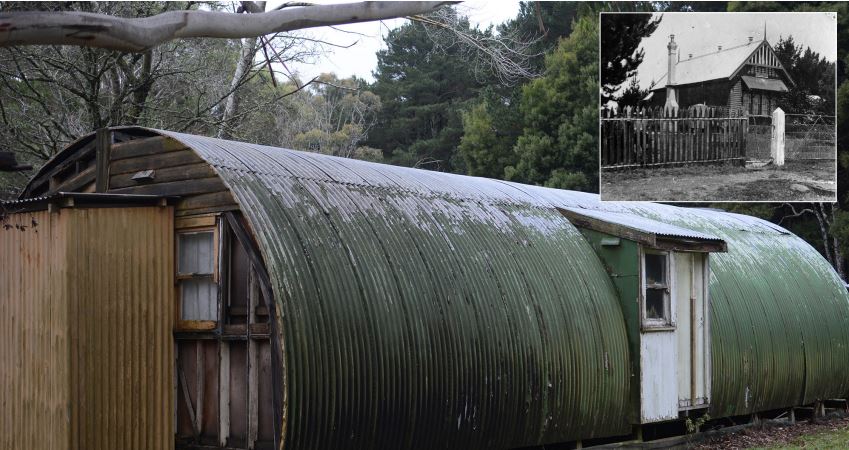June 7th, 2023Nissen huts at Lyonville link to our past

IN A region like the Central Highlands, decayed relics, disturbed ground and old structures are never far from view and traces of the past cling stubbornly to the present.
The little village of Lyonville is a typical example. While the sound of renovations echo through the surrounding bush and grand new houses emerge upon grassy fields, the mementoes of the past are ever present.
Old tanks totter on rotting stands, fuel bowsers, long dry, rust in the rain, an old railway bed and its dilapidated bridges hark back to the era when steam trains were the height of progress. An old weatherboard school, pictured inset, speaks to us of times when such places were the centre of small communities across the state.
The stories these relics tell us are, to a certain degree, common to every regional
town and evoke familiar narratives of growth and recession.
But within Lyonville there are two buildings, overlooked and ignored, that
embody a far broader historical narrative; one that ranges from military logistics
and the vast citizen armies of the Great War to the immigration diasporas of the
20th century. Nestled between the teacher’s residence and schoolhouse are a pair of
Nissen huts. They are basic structures, sitting on wooden stumps, a semicircular roofs
curving all the way down to the ground. Tree trunks push against them, windows are
broken, paint is peeling, moss advances across cracked and decaying steps.
Nissen huts are named after their inventor Major Peter Norman Nissen of the
British Army Royal Engineers and were developed during WWI. They were an
extremely simple design consisting of prefabricated semi cylindrical steel ribs that
could be adapted to various lengths and configurations. Their austere design reflected
the restrictions of wartime material shortages and they needed to be portable and easy
to erect so they could be shifted to other places when needed. A Nissen hut could be
erected by a six man crew in 4-6 hours.
Nissentenuts were mass-produced in their thousands in use in both World Wars,
and served as accommodation for troops, storage, field hospitals and mess halls.
Following World War II, surplus Nissen huts were sold by the federal government to
state and local authorities and were used for workshops, farm buildings, storage sheds,
and even churches. I even remember my parents bringing one to our farm on the
back of a truck in the early 1970s where it served as a store room for grain and hay.
They were also used as temporary housing to house the wave of immigrants from
the United Kingdom that came to Australia in the 1950s. These new arrivals, known
as ten pound poms (the cost of their passage to our shores) often spent their first years
living in these poorly insulated structures in hastily constructed migrant camps and
suburbs such as Belmont North in Newcastle.
They served a utilitarian purpose, tiny houses to address critical accommodation
shortfalls rather than some romantic alternative lifestyle. But as housing they were
generally unloved; they were draughty, cold in winter, boiling in summer and retained
a stigma stemming from their military origins.
A hut was not considered a home and many were quickly demolished or removed
to make way for more conventional housing. Today only people above a certain age
would even recognise a Nissen hut, let alone the history they represent. There are very
few of them still standing and most are in ruins. So to have two examples of these
unique buildings sitting forgotten in the grounds of the old Lyonville State School is
significant.
They most certainly were manufactured during World War II but it is unclear
when they were transferred to the Lyonville site. However, according to Lynn
Sunderland, author of Charlie’s Book, The Life and Times of a Country Town “even after
the (Lyonville) School officially closed in 1968, the school house and its collection of
WWII Nissen huts were the venue for regular school camps right up until 1994”.
Nonetheless it would seem that their ultimate fate will be to rot into the ground
like the rest. The site upon which they stand remains “under the management of the
Department of Education pending its disposal in accordance with Government policy
(and) is not listed with the Victorian Heritage Register”.
Decay is far slower than development and visitors to the town of Lyonville will
certainly have many more years of enjoyment of these “picturesque ruins”. However
in these times of economic uncertainty, housing shortages, and exorbitant rents, the
humble Nissen hut, symbol of low cost, quickly erected expedient housing may not
be a relic of the past. They could very well represent the future.
Words & main image: Tony Sawrey
School image: Courtesy of Trentham and District Historical Society










